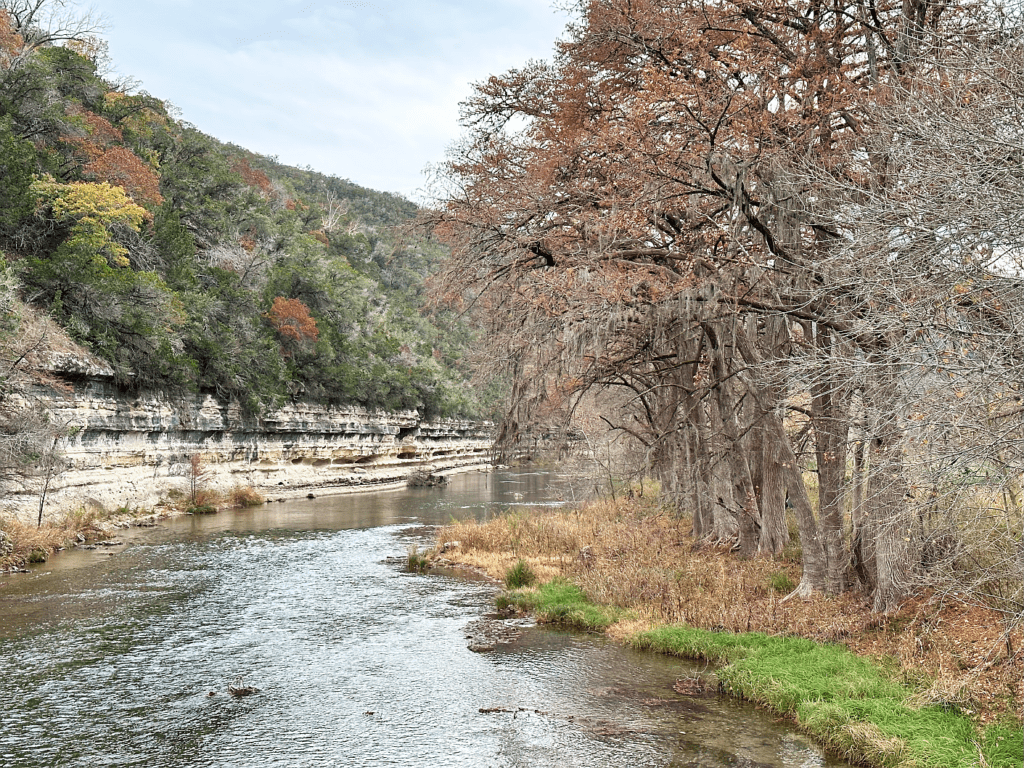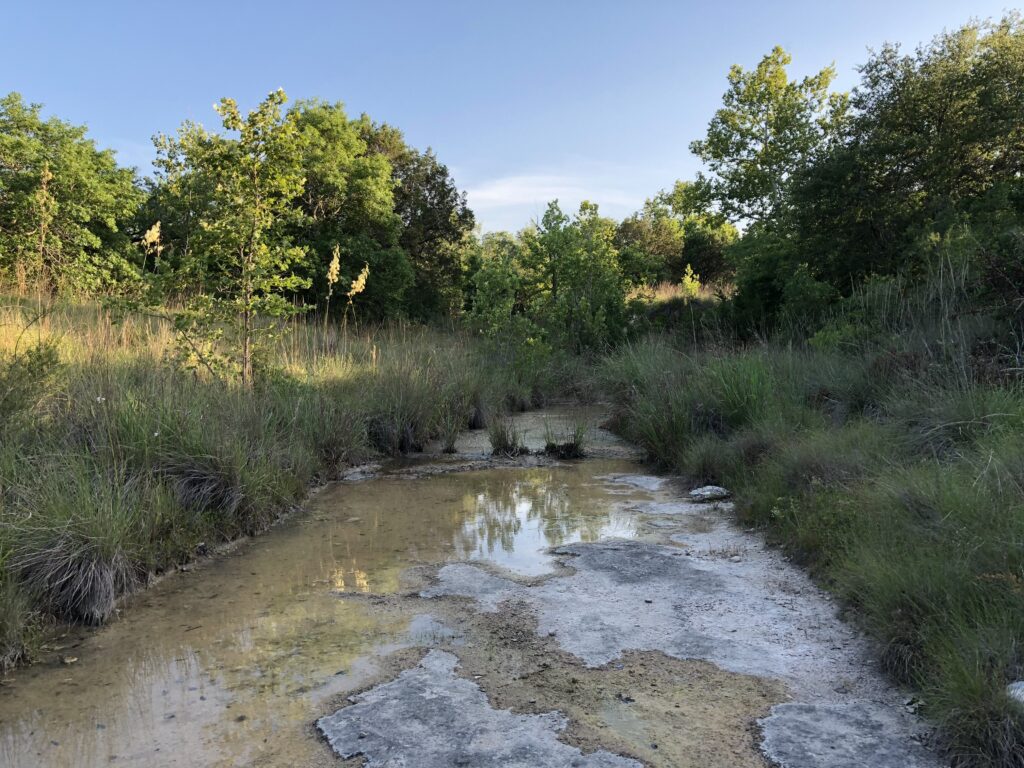What is a Riparian Zone?
A riparian zone or area is simply the transition or interface between relatively drier upland areas and wetter areas. The term “riparian” literally means “river bank.” It is the land the occurs on the edges of a body of water. Riparian areas can be found on the banks of rivers, creeks, ponds, lakes, wetlands, and bays. They are some of the most productive pieces of land, accounting for only 1% of all land on the planet. They are valuable because they provide habitat for insects such as fireflies, fish, and other wildlife, forage for grazing animals, and clean abundant water.
Riparian areas are functional because they are dependent on a specialized group of plants. This band of vegetation occurs in all sizes between the waterways and the upland areas. This zone functions as a durable long-term buffer against the extremes of drought and flood. The intersection of water, soil and vegetation interact in remarkable ways to determine the quality of our rivers, streams, and groundwater aquifers.

Types of Riparian Areas
There is a lot of variability in riparian areas and are usually classified according to the duration of flow. Perennial creeks and rivers flow continuously on the surface except in severe drought. Seasonal creeks will flow for limited periods but still maintain a connection to the water table below them. Ephemeral creeks only flow in periods of heavy rainfall or runoff and don’t have any connection to the water table. Usually, perennial and seasonal stream beds have riparian areas of varying densities. Ephemeral creeks, draws, and ravines have poorly defined riparian areas because they lack a contributing water table.
Because of the incredible variability of riparian zones, different management strategies will vary from place to place and should be site specific. It is recommended to contact experts in your region who are knowledgeable riparian professionals to help you develop specific management plans.
Riparian Zone Management
The guide below will help land managers select some fundamental management activities to care for your riparian area. The guide is meant to help you identify whether the riparian buffer on your land is healthy and functional, or dysfunctional and steps you can take to remedy it. It is to raise awareness to the value riparian zones have for fireflies and other wildlife. When we have healthy and functional riparian zones we also create better quality habitat for fireflies to thrive. It is another conservation step to take to help save fireflies from disappearing.
Get to Know Your Land
To evaluate your land, land managers should start by identifying potential sites that need preferential treatment and special management. Identify the riparian areas such as creeks, rivers, bottomlands, and marshes that could support fireflies. Evaluate the condition they are in. The following questions may help you in evaluating the condition of the land surrounding riparian and wetland habitats and developing appropriate riparian area management techniques to improve or protect existing riparian corridors.

What is a healthy riparian area?
Healthy riparian areas supports dense stands of densely rooted vegetation. Healthy, well-vegetated areas will appear overgrown, untrimmed, and shaggy. Is the habitat dense, bushy, and scruffy, with dead trees, logs, brush piles, or boulders? If so, your habitat is healthy, and you should take action to address the threats to this healthy habitat.
Why is it important to have a healthy riparian area?
Riparian areas serve as the last line of defense against changes in the landscape. A healthy riparian area is vital to supporting a healthy ecosystem which many plant and animal communities need to survive and thrive.
It’s a rivers job to drain the landscape, so its important to leave everything as you find it. We need the vegetation, it’s not sucking up the water, it’s contributing to the flow. The riparian area is just a tiny piece, just 1% of the whole landscape, and it’s the rivers last defense. When you have problems in the catchment and you have disturbances on the land. The last opportunity for a river to stay healthy is it’s riparian area.
– Sky Lewey, Noted Riparian Expert and Editor of Remarkable Riparian Field Guide
Benefits of a healthy riparian system include:
Clean Water – Plants in the riparian area contribute to water quality improvements by filtering sediments, nutrients and pollution before it runs off into the waterway.
Flood Mitigation – During large rainfall events or seasonal flooding, the vegetation in the riparian area work to slow down and stabilize the bank with their extensive root system. This helps minimize downstream impacts relating to property loss and destruction.
Reducing Erosion – Riparian plants along a river or stream act as a natural bank stabilizer, reducing erosion and preventing loss of valuable land.
Habitat for Wildlife – Healthy riparian zones protect biodiversity. They support the most biologically diverse parts of a landscape that could not thrive elsewhere by providing food, shelter and migration corridors for a wide variety of plants and animals (especially for fireflies).
Groundwater Recharge – Riparian areas help strengthen and increase the infiltration of water into the ground, helping to replenish aquifers and maintaining spring flows into rivers and creeks during periods of drought.
Recreational Value & Beauty – Healthy riparian areas are beautiful. They are universally appreciated for their significance in improving human well-being and fostering communities that thrive. They additionally hold cultural importance and provide recreational opportunities such as fishing, kayaking, hiking, and naturalist study.
Key actions to take if you have healthy riparian habitat might include:
- Meet with key stakeholders to discuss priorities for protecting firefly habitat by preserving natural buffers around riparian and spring complex habitats.
- Evaluate vehicle traffic in creek areas and riparian buffer zones. Consider rerouting roads and trails around these sensitive habitat areas.
- Eliminate excessive recreational activity and foot traffic.
- Identify invasive species whose excessive growth inhibits the ability of native riparian plants to establish and make plans to remove them.
- Fence off sensitive habitats and maintain these fences to ensure cattle and excessive populations of deer, exotic ungulates, and feral hogs do not find their way through.
- Eliminate any prolonged grazing by cattle in riparian areas. Consider rotational grazing to give areas adjacent to riparian corridors a long time to recover.
- Investigate the effects of proposed dams and other water changes that could negatively impact firefly habitat. Will some land be lost, and will adjacent riparian buffers be subjected to excessive erosion from flood waters?
- Protecting occupied sites from excessive or unnecessary pesticide application.
- Set up long-term monitoring programs at extant sites to gather baseline population data to better understand population trends and conservation status of this species over time, as well as insights into the impacts that various management activities have on firefly health and abundance.
- Place educational materials or signs in the firefly & wildlife habitat to educate others about the habitat’s importance to fireflies and why it is protected.
What is a dysfunctional riparian area?
Dysfunctional riparian areas lack sufficient vegetation to slow floodwaters and catch sediment. Is there any bare ground between the spare or unhealthy plants? Is the woody debris being removed or burned to help clean up the habitat? Does it look manicured, park-like, and open? If this is the case, you should take the steps listed below to help restore your riparian habitat, such as fencing and plant re-vegetation.
Key actions to take if you have dysfunctional riparian habitat include:
- Identify land management techniques that have become hindrances affecting the health of riparian habitats.
- Speak with everyone who is involved in using the land closest to the firefly habitat. How do they use it on a regular basis?
- Are new plants colonizing trapped sediment on the banks? Look for new plants, runners from existing plants in deposited sediment. What is hindering new plant colonization?
- Are banks covered with strong rooted vegetation that can withstand the energy of floodwaters? Identify the plants that currently occupy the banks. What is their age, is a diversity of young, middle aged and mature riparian plants present?
- Make a list of plants you wish to establish for a revegetation strategy, either as seed or live plants. Begin by researching some plants that are good for fireflies and search for seed suppliers that specialize in native plant seeds from your state or eco-region. Avoid buying seed from producers outside your state and free of invasive plants.
- Reduce disturbance with heavy equipment (such as during construction) along floodplain banks that contribute large sediment deposits.
- Stop mowing or spraying weeds or brush too close to creek and river banks.
- Avoid any timber harvesting or logging activities near the waterway.
- Discontinue burning brush piles in riparian areas that remove large dead wood or downed trees. Eliminate excessive recreational activity and foot traffic. Consider allowing access only seasonally to give areas a chance to rest in-between.
- Fence off sensitive habitats and maintain these fences to ensure cattle and excessive populations of deer, exotic ungulates, and feral hogs do not find their way through. Look for browse lines underneath vegetation to indicate a serious deer, exotic or goat problem.
- Provide educational material or install firefly & wildlife habitat signs to describe the reasons why certain practices are being carried to protect the riparian area.
- Remove or modify artificial light sources, such as streetlights, that may have a negative impact on populations (e.g., using motion sensors on existing lights or replacing bright LEDs with dim red bulbs that do not interfere with firefly flash communication).